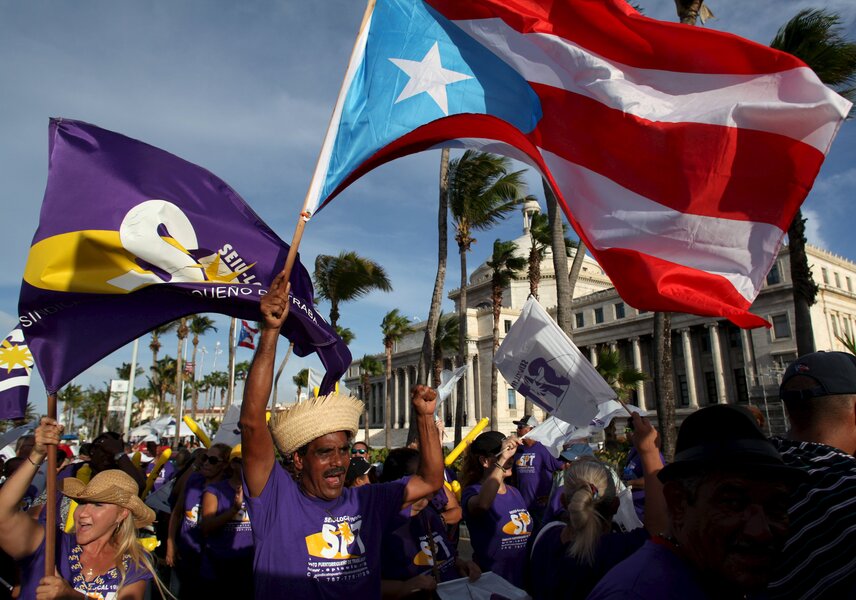As deadlines come and go, Puerto Rico's debt crisis grows
Loading...
Puerto Rico’s May 1 deadline on a $422-million debt payment has arrived, and US lawmakers are no closer to finding a solution for the island’s financial woes.
Most of Sunday’s payment is principal and interest due from the Government Development Bank, Puerto Rico’s main bond issuer and fiscal agent.
“That deadline is imminent, but Republicans in the House and Democrats in the administration are still haggling over the terms of a bill to rescue Puerto Rico,” writes The New York Times. “Missing the payment risks further destabilizing its shrunken economy. And there are concerns that the passage of any legislation could be delayed until the island nears the tipping point of its debt woes: a $2-billion debt payment due on July 1.”
Before Congress left Washington Friday for a weeklong recess, legislators were deadlocked over any plan that could be seen as similar to bailout bills of the 2008 financial crisis. Rep. Rob Bishop (R-Utah) is leading a draft of a tentative rescue plan in the House, but it has faced opposition from legislators in both parties who see the bill as nothing more than a bailout.
“For me, I think to any human being, ‘bailout’ means you’re going to get money to solve your problem,” said Representative Bishop. But the bill would “give Puerto Rico access to a court-enforced debt restructuring in exchange for the imposition of a federal fiscal oversight board,” so the island would get no direct money out of the deal. “So to say it’s a bailout, it’s obviously not just a stretch of the meaning of the word, there has to [be] an ulterior motive.”
Puerto Rico’s Governor Alejandro Garcia Padilla is frustrated with Washington’s inaction because he has warned about a default on Sunday’s deadline for months. And while Washington may be at a standstill, the financial crisis has everyday implications for the 3.47 million people who call Puerto Rico home.
The island’s unemployment rate was 11.8 percent in March, more than twice the overall US rate of five percent. Tens of thousands of government workers have been laid off since 2009 to cut costs and 10 percent of the island’s schools have been closed since 2014.
These personal hardships along with others have led to Puerto Rico’s largest mass exodus in the last 50 years. The island county has witnessed a 9 percent population decline in the 21st century, with almost seven percent occurring between 2010 and 2015.
“Population growth was once the norm in Puerto Rico,” explains Pew Research in a March study of population data from the US Census Bureau. “The island’s population grew by 10% from 1980 to 1990, and by 8% from 1990 to 2000. But as the effects of a decade-long economic recession have mounted, Puerto Ricans – who are US citizens at birth – have increasingly moved to the US mainland, with many settling in Florida.”
According to the Census Bureau data, economic opportunity is a primary driver for the mass outmigration: 40 percent of the island-born Puerto Ricans moving to the continental US say their main reason for moving was job-related, and another 39 percent cite "family and household" reasons.
But the continental US is not immune to Puerto Rico’s financial ills.
“A massive default from Puerto Rican bonds can create a financial contagion in the US municipal bond market,” Jose Caraballo-Cueto, Director of the Census Information Center at the University of Puerto Rico, writes for NBC News. And the new influx of Puerto Ricans to the continental US will further strain our country’s public services, adds Dr. Caraballo-Cueto, as the majority of islanders moving to the mainland are very poor. “Moreover, U.S. exports – especially agricultural products – to Puerto Rico will be reduced even further if the Great Depression of Puerto Rico deepens.”
And regardless of future side effects of the island’s bankruptcy on the overall US economy, the US government has “a shared responsibility” on Puerto Rico’s crisis, notes Caraballo-Cueto. Not only has the US banned Puerto Rico’s access to federal and local bankruptcy laws that could have restructured 70 percent of the country’s debt, but it has also upheld a marine law from 1920, the Jones Act, that cripples the country’s international trading by essentially only permitting US ships to enter or leave Puerto Rican ports as all other foreign vessels are subject to absurdly high customs and import fees.
“Most people think July 1 is atomic bomb day,” Sergio Marxuach, public policy director of the Center for a New Economy in Puerto Rico, tells The Washington Post. “May 1 is still significant.”






